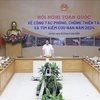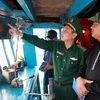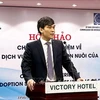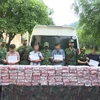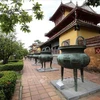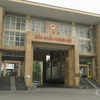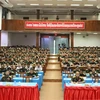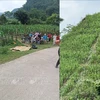In April 2009, the Prime Minister issued a system of criteria of the programme on building new rural areas. After three years of implementation, the programme has contributed to the change of the life in numerous rural regions. However, adjustments are now needed. Report by the Voice of Vietnam Radio.
Building new rural areas is a major initiative of the State. After three years, the programme has achieved many important results. The implementation has also revealed some problems including old ways of thinking and working. Adjustments and a more suitable approach will be needed to fulfill the programme’s criteria.
The national target programme on building new rural areas has been undertaken nationwide and rallied the active participation of the people. The programme, which sets 19 national criteria, has created breakthroughs in agriculture, farmers and the countryside. Many localities have built modern infrastructure and promoted production. The people’s living conditions have been improved remarkably.
However, the implementation has posed some difficulties which will require appropriate adjustments to the approach. Some localities have misinterpreted the 19 criteria of the programme. They have applied them rigidly or believed some criteria outweigh the others.
Tang Minh Loc, head of the Office of the National Steering Committee for the programme, said: "Generally, local officials have not thoroughly understood the programme. Over the past few years, we have focused on building infrastructure and improving production capacity, but have not paid attention to other criteria such as building public works, protecting the landscape and environment, and promoting local traditions and cultural identities."
Many localities have drawn lessons from their work. The administration of Tan Hong commune in Ba Vi district on the outskirts of Hanoi said the biggest lesson was to communicate with the people to make them understand the programme’s targets in order to rally their participation and consensus.
Tan Hong commune specialises in rice cultivation but it had only 316 hectares of scattered rice fields in its 8.8sq.km area. Since the implementation of the programme, the commune has asked the people to rezone 110 hectares of fields to enable the use of agricultural machines. The people donated 13,000sq.m of land to expand inter-field lanes and build 20 new roads.
Worthy of note, Tan Hong has achieved the new rural development criterion of preserving the landscape. The commune has an agricultural waste treatment facility. Locals actively collect waste and get involved in protecting the village environment.
Nguyen Thi Hai of the commune said: "In the first half of this year, we launched a campaign to clean up the environment. We encouraged families to tidy up their yards and built sanitation facilities under the new rural criteria."
Some localities have creatively carried out the programme to mobilise local resources in building public works, apply scientific and technological knowledge to agricultural production, rezone fields, use machines to plant and harvest rice, and expand markets.
“In 2009, 82% of the communes had met five out of the 19 criteria. This year, most have fulfilled three more criteria and only 29% of the communes have fulfilled just five criteria. We expect 300 communes to have completed all the 19 criteria by the end of this year,” Loc said.
The flexible application of new rural criteria has created fundamental changes in rural production. The programme will succeed only when the people understand its benefits and apply it at the grassroots level.-VNA
Building new rural areas is a major initiative of the State. After three years, the programme has achieved many important results. The implementation has also revealed some problems including old ways of thinking and working. Adjustments and a more suitable approach will be needed to fulfill the programme’s criteria.
The national target programme on building new rural areas has been undertaken nationwide and rallied the active participation of the people. The programme, which sets 19 national criteria, has created breakthroughs in agriculture, farmers and the countryside. Many localities have built modern infrastructure and promoted production. The people’s living conditions have been improved remarkably.
However, the implementation has posed some difficulties which will require appropriate adjustments to the approach. Some localities have misinterpreted the 19 criteria of the programme. They have applied them rigidly or believed some criteria outweigh the others.
Tang Minh Loc, head of the Office of the National Steering Committee for the programme, said: "Generally, local officials have not thoroughly understood the programme. Over the past few years, we have focused on building infrastructure and improving production capacity, but have not paid attention to other criteria such as building public works, protecting the landscape and environment, and promoting local traditions and cultural identities."
Many localities have drawn lessons from their work. The administration of Tan Hong commune in Ba Vi district on the outskirts of Hanoi said the biggest lesson was to communicate with the people to make them understand the programme’s targets in order to rally their participation and consensus.
Tan Hong commune specialises in rice cultivation but it had only 316 hectares of scattered rice fields in its 8.8sq.km area. Since the implementation of the programme, the commune has asked the people to rezone 110 hectares of fields to enable the use of agricultural machines. The people donated 13,000sq.m of land to expand inter-field lanes and build 20 new roads.
Worthy of note, Tan Hong has achieved the new rural development criterion of preserving the landscape. The commune has an agricultural waste treatment facility. Locals actively collect waste and get involved in protecting the village environment.
Nguyen Thi Hai of the commune said: "In the first half of this year, we launched a campaign to clean up the environment. We encouraged families to tidy up their yards and built sanitation facilities under the new rural criteria."
Some localities have creatively carried out the programme to mobilise local resources in building public works, apply scientific and technological knowledge to agricultural production, rezone fields, use machines to plant and harvest rice, and expand markets.
“In 2009, 82% of the communes had met five out of the 19 criteria. This year, most have fulfilled three more criteria and only 29% of the communes have fulfilled just five criteria. We expect 300 communes to have completed all the 19 criteria by the end of this year,” Loc said.
The flexible application of new rural criteria has created fundamental changes in rural production. The programme will succeed only when the people understand its benefits and apply it at the grassroots level.-VNA


